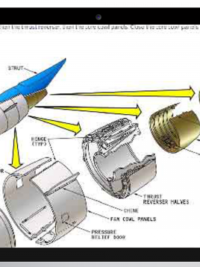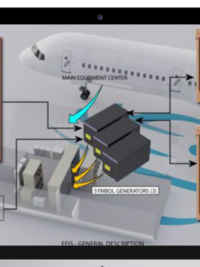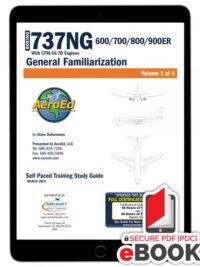Description
Course Content and Structure
The comprehensive training course for the Boeing 737 MAX equipped with LEAP-1B engines is meticulously structured to cater to a diverse range of Aircraft Maintenance Technicians (AMTs) and support personnel. At the core of the curriculum is a systems description as elaborated in the Aircraft Maintenance Manual (AMM), providing a detailed and technical overview of each system within the aircraft. This robust curriculum covers a spectrum of essential topics, including component locations, operations, maintenance prerequisites, and interfaces in both the cockpit and remote areas.
The course commences with an introduction to the fundamental principles and technical specifications of the Boeing 737 MAX, amplifying knowledge on its upgraded features and capabilities. Each subsequent module is designed to delve into various systems such as the airframe, avionics, electrical systems, and the LEAP-1B engine specifics. It meticulously addresses the operation mechanisms, troubleshooting procedures, and maintenance documentation, essential for ensuring optimal performance and reliability of the aircraft.
Interactive elements such as chapter quizzes are employed throughout the course to assess comprehension and retention of the material. These quizzes aid in reinforcing the knowledge acquired, facilitating a progressive learning experience. The course structure is deliberately flexible, accommodating the learning pace of participants and allowing an extended period of one year from the start date for completion. Upon successful culmination, participants are awarded a certificate of completion, validating their proficiency and readiness for practical applications.
Adhering to stringent industry standards, this training meets the ATA 104 and EASA Part 66 Level 1 requirements, ensuring that it aligns with globally recognized aviation maintenance education benchmarks. Whether for new AMTs, base and line operations personnel, or those prepping for job interviews, this course provides a solid foundation and enhanced familiarity with the Boeing 737 MAX’s advanced systems. This structured and well-rounded approach equips trainees with the practical skills and theoretical knowledge necessary to excel in the dynamic field of aircraft maintenance.
Additional Benefits and Management Integration
The comprehensive training course on the Boeing 737 MAX with LEAP-1B engines extends beyond technical acumen, offering numerous additional benefits that amplify the competency of Aviation Maintenance Technicians (AMTs). Upon course completion, participants will master a suite of safety precautions and maintenance practices crucial for handling advanced aircraft technologies. The detailed exploration of major system layouts and the intricate characteristics of the LEAP-1B powerplant contributes significantly to the technicians’ proficiency.
Furthermore, the training delves into the specific tooling and test equipment used with the Boeing 737 MAX, ensuring that AMTs are well-versed in the operational aspects of these tools. This pragmatic approach enhances the technicians’ ability to perform precise diagnostics and maintenance, thereby optimizing aircraft performance and safety.
Another significant advantage of the course is the award of IA renewal credit, coupled with FAA AMT Award Points, upon successful completion. These certifications not only validate the technicians’ enhanced expertise but also contribute to their career advancement by reinforcing their credentials with recognized industry standards.
For training managers, the self-paced training modules stand out as a cost-effective and efficient solution to meet both initial and recurrent training needs. The flexibility of these modules allows teams to undergo training during ‘down times,’ thereby ensuring uninterrupted operations while maintaining a highly skilled workforce.
Integrating this training method into existing programs can be seamlessly achieved with strategic planning. Training managers are encouraged to incorporate these modules into their regular schedules, using downtime effectively and ensuring their teams remain up-to-date with the latest maintenance practices and safety protocols.
For further assistance and inquiries, training managers and AMTs can contact the program’s support team. Dedicated assistance is available to help integrate the course efficiently into existing training structures, ensuring that organizations derive maximum benefit from this advanced training opportunity.
Detailed Course Discription
- ATA 01 – Aircraft General
- ATA 05 – Scheduled/Unscheduled Maintenance
- ATA 06 – Dimensions/Areas
- ATA 07 – Lifting, Shoring, Recovering, and Transporting
- ATA 08 – Leveling and Weighing
ATA 09 – Handling and Maneuvering
- Towing, Landing Gear Downlock Safety Pins, Taxiing, Turning Radius, Hazard Areas, Engine lntake and Exhaust Hazard Areas, Parking, Mooring, Storing, and Return to Service, Covers and Plugs, Exterior Plugs, Grounding, Landing Gear Grounding Studs.
ATA 11 – Placards and Markings
- External Placards and Markings, lnterior Placards.
ATA 12 – Servicing
- Servicing Panels and Doors, Ground Support Equipment Placement.
ATA 21 – Air Conditioning
- General Description, Temperature Control, Distribution, Ventilation, Equipment Cooling, Pressurization, Forward Cargo Compartment Heating, Aft And Bulk Cargo Compartment Heating, Crew Rest Area Heating, Supplemental Heating, Control, Indications, Tests.
ATA 22 – Autoflight
- Autopilot Flight Director System, AFDS – Main Equipment Centre Component Location, Thrust Management Computing System (TMCS), TMCS – Flight Deck Component Locations.
ATA 23 – Communication
- Speech Communication, HF Communication System, VHF Communication System, Emergency Locator Transmitter, Aircraft Communications Addressing and Reporting System (ACARS), SELCAL System, Passenger Address System, Passenger Entertainment System, Cabin Video Information System, Service Interphone System, Flight and Ground Crew Call System, Flight Interphone System, Static Discharger, Voice Recorder System, Cockpit Door Surveillance System, Flight Compartment PC Power.
ATA 24 – Electrical Power
- Electrical Power Introduction, Electrical Power – Power & Control, Electrical Power – Distribution, Electrical Power – Component Locations, Electrical Load Management System (ELMS), AC Generation, APU Generator And IDG Power Systems, Backup Generator Power System, Main Equipment Center, DC Generation, DC Generation – Subsystems, DC Generation, RAT, DC Generation – Description, Standby Power, Flight Controls DC Power, External Power, Ground Service Switch, Electrical Power Control, Indication.
ATA 25 – Equipment and Furnishings
- Cabin Accommodations, Flight Compartment, Flight Compartment Equipment, Passenger Compartment, Seats – Passenger, Service Units, Galleys, Lavatories, Lavatory Area, Electronic Compartment, Cargo Compartments, Sliding Carpet Cargo Loading System, Emergency.
ATA 26 – Fire Protection
- Engine Fire Detection, Lavatory Smoke Detection, APU Fire Detection System, Lower Cargo Compartment Smoke Detection, Wheel Weil Overheat Detection System, Wing and Lower Aft Body Overheat Detection System, Engine Fire Extinguishing, APU Fire Extinguishing System, Lower Cargo Compartment Fire Extinguishing, Lavatory Fire Extinguishing System, Portable Fire Extinguishing.
ATA 27 – Flight Controls
- Flight Control Systems Introduction, Flight Controls, Flight Control Shutoff Valves, PFCS Operational Overview, PFCS Modes Of Operation, PFCS – Analogue Interfaces, Actuator Control Electronics (ACE), PFCS – Flight Controls ARINC 629 Bus Interfaces, Primary Flight Computers (PFCs), PFC – Control Laws, PFCS – Electrical Power, Hydraulic Power Distribution, PFCS Roll Control, Flaperon and Aileron Components, Spoiler and Speedbrake Control, Auto Speedbrake Control, Yaw Control, Rudder Control Component Locations, Pitch Control – Elevator, Pitch Control – Stabilizer, Flight Controls Synoptic Display, High Lift Control, High Lift Control System (HLCS), High Lift Control System (HLCS) – Alternate Mode, Flap/Slat Electronics Unit, Flap/Slat Component Locations, Flap Skew Detection System, Leading Edge Slats Components, Slat Skew Detection System, Flap/Slat Load Relief, Autoslat Extension, Flap/Slat Position Displays, HLCS Maintenance Page Format.
ATA 28 – Fuel System
- Fuel Quantity Computer, Fuel Storage, Vent System, Refuel/Defuel System, Refuelling, Defueling, Engine Fuel Feed, APU Fuel Feed, Fuel Transfer System, Fuel Controls and lndications, Safety.
ATA 29 – Hydraulic Power
- Green, Yellow & Blue Systems, Reservoirs, Engine Driven Pumps, Electric Pumps, Power Transfer Unit, Fire Shut-Off Valves, Ram Air Turbine, Component Locations, Maintenance/Test Facilities.
ATA 30- Ice & Rain Protection
- Ice Detection System, Wing Anti-lce System, Cowl Anti-lce System, Probe Heat System, Windshield and Side Window Heating System, Windshield Wiper System, Controls and lndications.
ATA 31 – Indicating and Recording Systems
- Airplane Information Management System (AIMS), Airplane Information Management System (AIMS), AIMS Cabinets, Avionics Systems Supported By AIMS, AIMS – Main Equipment Centre Component Locations, AIMS – Data Conversion Gateway Function, AIMS – System Ground Tests, LRU Tests and Operational Tests, Primary Display System, Primary Display System, Primary Display System – OPAS Interface, Primary Display System – Synoptic Formats, Primary Display System – Maintenance Pages, Ground Manoeuvre Camera System, ACMS – Aircraft Condition Monitoring System, Systems Card Files, Warning Electronic System, Warning Electronic System – Component Location, Flight Data Recorder System, Clocks, Flight Compartment Printing System.
ATA 32 – Landing Gear
- Landing Gear, Nose Landing Gear, Main Landing Gear, Main Landing Gear Downlock Pins, Gear Door Ground Operation, Landing Gear Door Unsafe Lights, Landing Gear Control System, Alternate Extension System, Component Location, Nose Wheel Spin Brakes, Main Landing Gear Wheels, Brake System, Antiskid/Autobrake System, Parking Brake System, Brake Temperature Monitoring System, Nose Steering, Tail Strike System, Air/Ground System, WOW Load Sensor, Proximity Sensor System (PSS), Landing Gear Position Indicating and Warning System, Indication.
ATA 33 – Lighting System
- Flight Compartment Lights, Flight Compartment Lights – Spare Lamps, Passenger Compartment Illumination, Service and Cargo Loading Lights, Service and Cargo Loading Lights – Main Wheel Well Locations, Service and Cargo Loading Lights – Nose Wheel Well Locations, Service and Cargo Loading Lights – Cargo Loading Lights, Exterior Lights, Exterior Light Control, Emergency Lighting, Emergency Lighting – Exit Signs, Emergency Lighting – Slide Lights, Emergency Lighting – Power Supplies, Emergency Lighting.
ATA 34 – Navigation
- Navigation Systems, Air Data Inertial Reference System, ADIRS, Pitot–Static/Air Data Standby Instruments, Flight Deck Component Location, Standby Airspeed Indicator/Altimeter, Standby Magnetic Compass, Standby Attitude Reference System, VHF Omnidirectional Ranging System, Air Traffic Control/Mode S Transponder System, Distance Measurement Equipment System, Automatic Direction Finder System, Global Positioning System, Radio Altimeter System, Weather Radar System, Traffic Alert And Collision Avoidance System, Ground Proximity Warning System, Flight Deck Component Locations, Flight Management Computing System, Instrument Landing System, Marker Beacon System.
ATA 35 – Oxygen
- Crew Oxygen, Passenger Oxygen, Portable Oxygen.
ATA 36 – Pneumatic
- lntegrated Air Management System, Pneumatics, Bleed Air Sources, Engine Bleed Air, APU Bleed Air, High-Pressure Ground Connection, Bleed Air Leak and Overheat Detection System, Controls and Indications.
ATA 38 – Water and Waste
- Potable Water System, Gray Water Drains, Vacuum Waste System, Controls and Indications.
ATA 44 – Cabin Systems
- Cabin Management System, Aircraft Systems, Cabin and Passenger Functions, Onboard Communication, Emergency Evacuation System, ln-flight Entertainment and Connectivity.
ATA 46 – Information System
- Information Management System, Aircraft Health Management, Aircraft Network Architecture.
ATA 47 – Fuel Tank Inerting System
- Fuel Tank lnerting System, System Generation, Distribution.
ATA 49 – Airborne Auxiliary Power
- APU Power Plant, Shroud, Mounts, Air Inlet, Shroud Drains, Engine, Fuel System, Ignition and Start System, Cooling Air System, Bleed Air System, Controls, Exhaust Gas Temperature Indicating System, Indicating System, Exhaust System, Lubrication System, Oil Indicating System.
ATA 50 – Cargo Compartments
- Forward Cargo Compartment, Aft Cargo Compartment, Compartment Nets.
ATA 51 – Structures
- Aircraft Structure Repair Publication, Standard Practices, Clean-up, and Aerodynamic Smoothness, Damage Assessment, Permitted Damage, Repairable Damage, Composite Damage Assessment.
ATA 52 – Passenger and Service Doors
- Overwing Emergency Exit Doors, Cargo Compartment Doors, Equipment Bay Doors, Remote Access System, Controls and lndications.
ATA 71 – Powerplant
- Engine, Engine Fuel and Control, Ignition, Air, Engine Controls, Engine Indicating, Exhaust, Oil, Starting.










Reviews
There are no reviews yet.